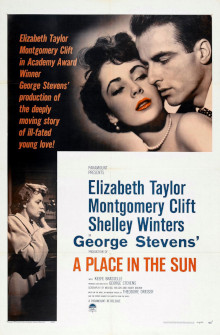- Franz Waxman
A Place in the Sun (1951)
(A Symphonic Scenario)- Sony / ATV Songs LLC (World)
arr. Christopher Palmer
- 2(II:pic).2(II:ca).2+bcl.2(II:cbn).asx[=ssx]/4.3.3.1/timp.3perc/pf.hp/str
- 13 min 17 s
Programme Note

Sections
Prelude
The Two Girls
Vickers’ Theme
The Drowning
Farewell and Frenzy
Witness Montage
George’s Story
The Last Mile
Note
Recent enough to tap into many people’s experience, sufficiently remote also to admit of nostalgia, the period of the Fifties seems to be, in movie terms, particularly familiar and appealing to today’s audiences.
The decade began with Gloria Swanson’s pronouncement, in Sunset Boulevard, that the movies had ‘gotten small’ – a challenge to which producer-director George Stevens threw down the gauntlet in the form of his so-called ‘American’ trilogy: A Place in the Sun (1951, Paramount; based on Theodore Dreiser’s novel An American Tragedy), Shane (1953), and Giant (1956), all ‘big’ pictures, ‘epic’ in terms not only of space and time but also of the myths and moral complexities they embrace.
I mentioned Sunset Boulevard (1950) advisedly, for it was Franz Waxman’s work on this Billy Wilder masterpiece, which may, I think, have led directly or indirectly to some of the problems he encountered in A Place in the Sun.
Sunset Boulevard, being a comment by Hollywood on Hollywood, needed the music’s connivance in underlining its ironic tone and making its critical points. Waxman clearly felt this to be a suitable departure-point for A Place in the Sun, which was, if reduced to its most basic terms, a love story gone madly, badly wrong. So Waxman created one of his most glorious love themes but subjected it to some inglorious treatment. The music is often cynical and jazz-inflected and is of a piece not only with the temper of the film – and of the times – but also with Waxman’s own ongoing development, influenced as it surely was by contemporary trends in Hollywood music.
Jazz and jazz-oriented idioms were definitely flavor of the month, of the year, of the decade: A Streetcar Named Desire, with Alex North’s music, appeared in the same year as A Place in the Sun, and the next few years saw Leith Stevens composing The Wild One (1954), Elmer Bernstein’s The Man With The Golden Arm (1955) and Leonard Rosenman’s Rebel Without A Cause (1955). These are all composers of a newer generation than Waxman’s; in fact, Waxman responded to jazz more positively than any of his contemporaries, as one can hear in A Place In The Sun (albeit en passant) and, more consistently and confidently, in his scores for Alfred Hitchcock’s Rear Window (1954) and for Crime in the Streets (1956), a pre-West Side Story drama of rival gangs.
In other words, starting with A Place in the Sun, Waxman may be said to have made his own contribution to the evolving ‘teenage’ idiom of Fifties film music, anti-romantic and neo-expressionistic.
A ‘teenage’ idiom, however, was not precisely what George Stevens had in mind for A Place in the Sun. He was far from happy with much of Waxman’s music as he originally composed it, so much so that he called in two other composers, Victor Young and Daniele Amfitheatrof, and asked them to re-write certain scenes. This they did (using Waxman’s thematic material, however) with the result that the score in the film as we know it, the one for which Waxman won his second Academy Award (the first was for Sunset Boulevard), is only about sixty percent authentic Waxman. Clearly what Stevens wanted musically was something considerably more conventional, something that would soften the pictures’ edges rather than harden them, something that would sweeten the medication.
Director Stevens loved the saxophone theme for Elizabeth Taylor – she didn’t – but expected it to indulge and luxuriate in the old-Hollywood style to which he was accustomed. Waxman’s approach was often too stark, too dissonant, too comfortless, and would probably have engaged too little audience sympathy for the anti-hero (Montgomery Clift).
– © Christopher Palmer

 Located in the UK
Located in the UK
 Located in the USA
Located in the USA
 Located in Europe
Located in Europe
